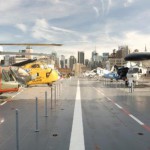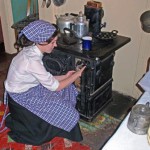By Victor Block

Standing on a half-acre of bog land which encircles a dilapidated 19th-century stone cottage, my mind wandered back to a recent visit to Ireland. The little structure, vegetation and even the rocks scattered about the site were identical to those I recalled seeing on the Emerald Isle. Then the view of skyscrapers surrounding the setting, and sound of honking automobile horns rather than bleating of sheep, startled me back to reality.
That was my introduction to the Irish Hunger Memorial in New York City. In that compact space, it provides a moving recollection of the Great Irish Potato Famine which, between 1845 and 1852, resulted in nearly a million deaths and forced millions more people to emigrate to the United States.
The memorial includes more than 100 moving quotations from letters, poems and songs which recall that history. The two-room cottage, which was donated by a family whose ancestors occupied it in County Mayo since 1820, had been dismantled and rebuilt at its present location.
The Irish Hunger Memorial is but one of many smaller, lesser-known museums that visitors to New York City often overlook, and that’s a shame. These little gems present chapters of American history which are as varied as they are intriguing.
The lives of other immigrants come to life in a non-descript five-story brick building which, from 1863 to 1936, served as home to more than 7,000 people. Detailed research enables historical interpreters to dramatize and humanize their stories at the Lower East Side Tenement Museum.
The hallways are dank and dark, with peeling wallpaper and cracked plaster. Stepping into a tiny 325-square-foot apartment, I learned that when the German-Jewish Gumpertz family lived there in the late 19th century – Natalie, her shoemaker husband and four children — it lacked heat, running water and bathroom facilities. By the time Adolfo and Rosario Baldizzi from Palermo, Italy, moved into the building decades later, running cold water and a sink, which doubled as a tub for weekly family baths, must have seemed like a luxury.
A very different culture is explored at the Museum of Chinese in America. It describes the influx of Chinese into the United States which coincided with the flood of immigrants from Eastern Europe. Many early members of “the Asian invasion” were men who came to help build the transcontinental railroad and toil at other sweat-inducing jobs. Along with a collection of artifacts, newspapers, photographs and other items, the story is told by means of oral histories, walking tours and film festivals.
The tale of the true Native Americans comes to life at the National Museum of the American Indian. Exhibits present the culture and traditions of Native Peoples throughout the Western Hemisphere, from their earliest history to the present. Among numerous treasured items are an exquisite Olmec jade head believed to have been carved as early as 900 B.C. and a magnificent Crow warrior’s robe.
More intriguing to a group of middle-school students who were sharing my time at the museum was a description of the use of animal intestines and bladders to store liquids. “Yuck” and “gross” were among the youngsters’ more polite exclamations.
While hardly of gourmet quality, food that was served to crew members aboard a World War II aircraft carrier probably received a more welcome response. The story of the challenge of feeding 3,000 sailors is one of the interesting narratives told aboard the USS Intrepid aircraft carrier.
Docked at a pier on the Hudson River, the massive ship is the centerpiece of the Intrepid Sea, Air & Space Museum. Nearly two dozen aircraft are parked on the flight deck, and interactive exhibits offer opportunities to experience a flight simulator and clamber aboard a helicopter. Most dramatic is the “Kamikaze” multimedia experience which includes smoke and flame effects that bring to realistic life the day when the Intrepid was struck by two Japanese suicide planes.
At the opposite end of the size scale is a museum which is closely associated with what many people picture when they think of New York City. At the compact Skyscraper Museum, scale models of some of the tallest buildings in the world are impressive beyond their size. Also intriguing are two hand-carved miniature wooden models of downtown and midtown Manhattan. Imagine a 4.7-inch tall Empire State Building and 10 Lilliputian-size city blocks that can fit in the palm of your hand. My conclusion: When it comes to museums in New York, even little things can make a big impression.
Photos/Victor Block













